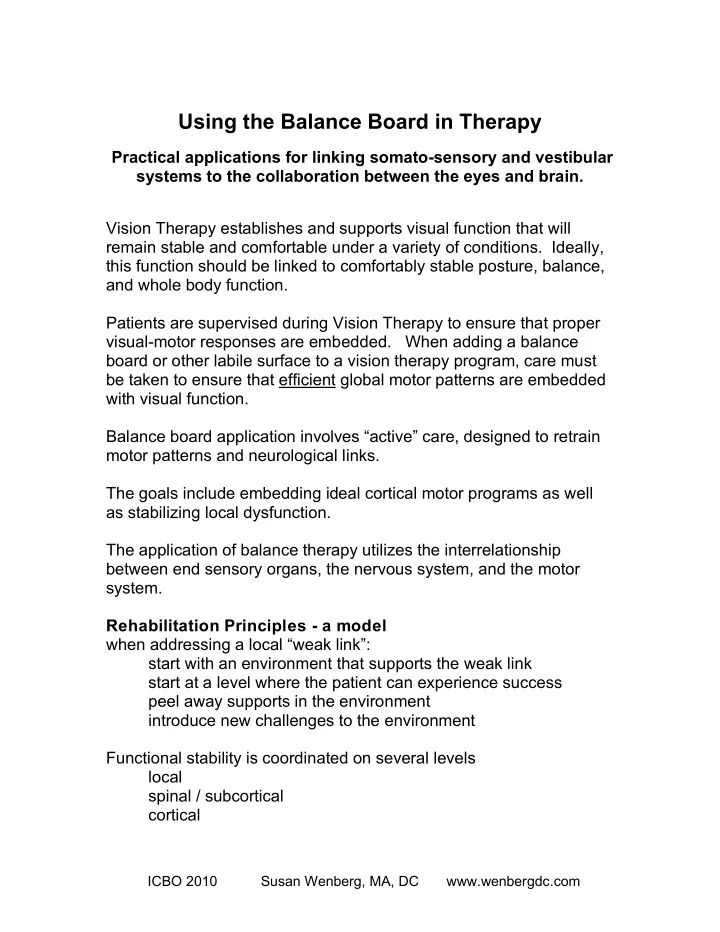

Using the Balance Board in Therapy Practical applications for linking somato-sensory and vestibular systems to the collaboration between the eyes and brain. Vision Therapy establishes and supports visual function that will remain stable and comfortable under a variety of conditions. Ideally, this function should be linked to comfortably stable posture, balance, and whole body function. Patients are supervised during Vision Therapy to ensure that proper visual-motor responses are embedded. When adding a balance board or other labile surface to a vision therapy program, care must be taken to ensure that efficient global motor patterns are embedded with visual function. Balance board application involves “active” care, designed to retrain motor patterns and neurological links. The goals include embedding ideal cortical motor programs as well as stabilizing local dysfunction. The application of balance therapy utilizes the interrelationship between end sensory organs, the nervous system, and the motor system. Rehabilitation Principles - a model when addressing a local “weak link”: start with an environment that supports the weak link start at a level where the patient can experience success peel away supports in the environment introduce new challenges to the environment Functional stability is coordinated on several levels local spinal / subcortical cortical ICBO 2010 Susan Wenberg, MA, DC www.wenbergdc.com
Local and global stabilization are interrelated: Global stabilization is required for effective local function. Local dysfunction alters global muscle tone and movement patterns. What are the consequences of embedding a poor compensatory motor pattern? Why are balance devices used in neuro-musculoskeletal rehabilitation? “loading” extremity injury rehabilitation ankle sprains, knee injuries, etc spinal and disc stabilization posture enhancement stimulate automatic postural reactions enhancing core stability efficient and safe global movement patterns increase joint ranges of motion enhance coordination heighten arousal >>> cortical motor programming Principles of Training -- this is central nervous system training control speed to contraction endurance reflex stimulation Assessing the patient on a labile surface: aside from visual skills, what should I monitor? posture movement motor recruitment autonomic responses What are the dangers with balance therapy? falling > injury not falling > injury neurologic or metabolic overstimulation ICBO 2010 Susan Wenberg, MA, DC www.wenbergdc.com
Cues to facilitate proper global and local stabilization? model for the patient be brief and to the point use cues that are: kinesthetic visual auditory How much is too much? Do not let them practice a poor pattern. Stop or go back to something easier A few hint and concepts slow controlled find the endpoints stay within the endpoints omitting vision cervical rotation with or without fixation eye motion one foot ball toss talking reading aloud visual exercises Types of labile surfaces for the clinical setting rocker board wobble board posture board trampoline foam baps board balance sandals ball disc ICBO 2010 Susan Wenberg, MA, DC www.wenbergdc.com
Types of labile surfaces in the patient’s world uneven ground soft surfaces shoes high heels special technology shoes Safety non- slip surface such as carpet corner of the room no dangerous objects nearby appropriate shoes or barefoot spotting the patient patient selection What are the common mistakes to avoid? missing pertinent signs and symptoms training the patient at too high a level training the patient too long poor patient preparation and selection How do I prepare the patient? facilitation mobilization Additional advantages of balance therapy simple affordable patients can experience the progress potential for home use What are relative contraindications for balance therapy? neuropathy metabolic insufficiency frank unstable joint inflammation ICBO 2010 Susan Wenberg, MA, DC www.wenbergdc.com
Shared concepts and key words diadochokinesis Sherrington’s Law of Reciprocal inhibition fixation suppression inhibition diadochokinesis fatigue functional stability A comment about tone: Tone is a function of both CNS mediated tissue tension and also mesenchymal tissue structure. A comment about development: The quality of the developmental process is reflected in morphological structure as well as motor function. Poor CNS function = poor morphological development. References Conservative Management of Cervical Spine Syndromes Dan Murphy DC McGraw-Hill 1999 Low Back Syndromes: Integrated Clinical Management Craig Morris McGraw-Hill Medical 2005 Rehabilitation of the Spine: A Practitioner's Manual 2nd edition Craig Liebenson DC Lippincott Williams & Wilkins 2007 Strabismus and Amblyopia Donald J Getz OEP 1990 Vestibular Rehabilitation , 3rd Edition Susan J. Herdman F A Davis Co 2007 ICBO 2010 Susan Wenberg, MA, DC www.wenbergdc.com
Recommend
More recommend